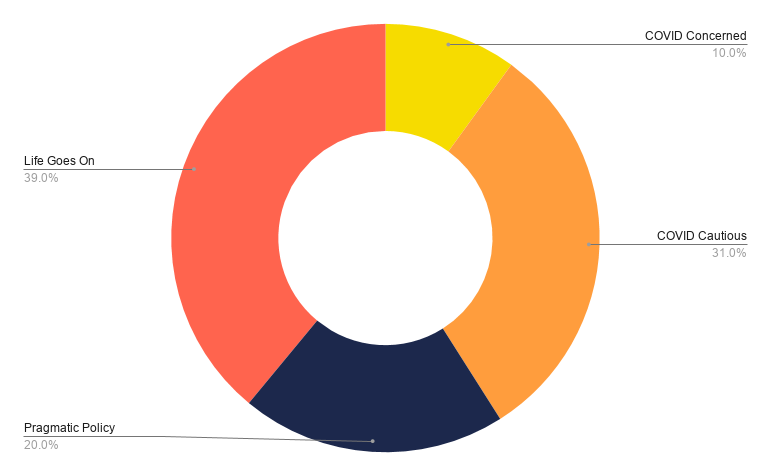What are the COVID Consumer Segments?

Pretty much since the global pandemic was declared, the diligent people over at BVA BDRC have been producing some excellent weekly reports on how UK consumers have been feeling about the effects of COVID-19. After 21 weeks, they are now taking a much-deserved break, but I do recommend checking out their final report when you next have a free moment as it is full of some great insights.
I’ve been following quite a few COVID trackers, but one reason why BVA BDRC’s report stood of for me is that they have developed the ‘COVID Consumer Segments’ rather than treating the whole of the population as one homogenised group. When creating marketing strategies it’s a common (and good) practice to separate by attitudinal segments as they create different consumer journeys – and why should the impact of COVID be any different?
The COVID Consumer Segments
COVID Concerned
People who fall under the COVID Concerned segment are those that have been most greatly affected by the pandemic – either by contracting the virus itself or being extremely anxious to do so.
Naturally, this group has reported the lowest mood during lockdown months and their anxiety about COVID and the governmental response to the situation has meant they by far the least likely of any segment to resume to ‘normal’ behaviour. Many people in this segment are still feeling financial and health implications, and will likely remain with this attitude until a cure is found.
COVID Cautious
COVID cautious people are less concerned about the personal impact of the pandemic but are more concerned about what the long term effects are and so would prefer a longer lockdown. They don’t feel we are past the worst of it and as a result, are more likely to to be apprehensive with their post-lockdown behaviour – especially if they involve large crowds.
As time has gone on they are starting to take public transport and interact with businesses with large amounts of outdoor space, but as a general rule are reluctant to engage in many leisure activities and tourism businesses.
Pragmatic Policy Supporters
Those who fall in the ‘Pragmatic Policy Supporters’ category think the worse is over, and we are on the way up. They may be concerned about long term impacts, but they are trusting and supportive of government policies and believe they serve our best interests.
As a result, they are willing to participate in activities that have been deemed safe such as eating at restaurants, staying in hotels and going to indoor attractions but they are still wary and prefer to know that the recommended precautions are being taken.
Life goes on
Simply put, people in this segment just want it all to be over.
They have been early adopters of activities once things have begun to re-open and believe that it is important to help stimulate businesses again to support the economy. They do still believe that precautions need to be taken, but have a more relaxed attitude towards safeguarding measures and are more likely to support a full lift of lockdown.

Focus on who will listen
The fact is, some people are just not going to want to engage with you right now, no matter how much you emphasise your safety changes and try to reassure them. In fact, 30% of COVID Concerned people have said that they will not interact with a leisure business at all until a vaccine is found.
The good news, however, is that while capacity is limited you can easily fill your available bookings in the short term by talking to the segments that will listen – namely the Pragmatic Policy Supporters and Life Goes On.
Generally, the public’s sentiment towards COVID-19 is beginning to relax. Someone’s first time with any activity will always be the hardest, and schemes like ‘Eat out to Help out’ have been great at building people’s confidence in resuming social activities. This confidence will only grow as time goes on and people interact more with tourism businesses and continue to have positive experiences.
Even if you have positive things to say, don’t use COVID as your primary marketing message. The changes you have made and your safety information should still be easily accessible as it will assure those in more reluctant segments, but it doesn’t need to be the first thing you say to a potential customer. Make sure to especially steer clear of messaging that centres around how your company has ‘done good’ during the pandemic as it is being seen as virtue signalling and becoming increasingly less effective, and in some cases, it even acts as a deterrent.
Instead, focus on the experience you are bringing your customers – it’s what they have been missing. Nearly 40% of the population is wanting to get back to a sense of normality, so your marketing should reflect that.
Activate your digital channels
Though people are starting to spend more outdoors, the best way to reach your audience is still through digital channels. Digital channels have changed the travel consumer journey and the pandemic has further created a shift towards people interacting online with tourism businesses.
During lockdown, 47% of people reported that they have been spending significantly more time on social media across all age groups aged 16-64. Many of these people have said that they expect that these increased levels of engagement will remain the same even when things go back to ‘normal’. Therefore having a strong social media presence and strategy is integral for reaching potential customers, as this is where they are gathering information and planning their days – especially while not all businesses are open.
For our clients, we have been recommending a strong combined PPC and social advertising strategy, which so far has been incredibly successful during the ease of lockdown. In the last two months, we have generated over £4m of sales across our clients, that are a mix of indoor and outdoor attractions and hotels.
Are you struggling to fill all your available booking slots? Please get in touch to see how we can help.
Update 22/10/20
Since this article was written BVA-BDRC have evolved their COVID Consumer Segments as part of the launch of their new service Clearsight. For an updated version of the segments and what they mean for your marketing then check out the new article here.
Jamie is Digital Visitor's Marketing Manager and oversees our messaging and content. If you are interested in knowing more about anything covered in this blog, or would like to see more on a certain topic please drop them an email.










